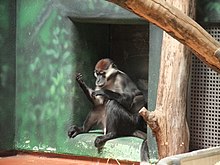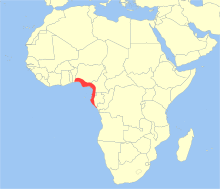Collared mangabey
| Collared mangabey[1] | |
|---|---|

| |
| Scientific classification | |
| Domain: | Eukaryota |
| Kingdom: | Animalia |
| Phylum: | Chordata |
| Class: | Mammalia |
| Order: | Primates |
| Suborder: | Haplorhini |
| Infraorder: | Simiiformes |
| Family: | Cercopithecidae |
| Genus: | Cercocebus |
| Species: | C. torquatus
|
| Binomial name | |
| Cercocebus torquatus (Kerr, 1792)
| |

| |
| Geographic range | |
The collared mangabey (Cercocebus torquatus), also called red-capped mangabey and white-collared mangabey,
Description
The collared mangabey has grey fur covering its body, but its common names refer to the colours on its head and neck.
Distribution and habitat
The collared mangabey is found in coastal, swamp, mangrove, and valley forests, from western Nigeria, east and south into Cameroon, and throughout Equatorial Guinea, and Gabon, and on the Gabon-Congo border by the Atlantic shore.[2]
Behavior and ecology
The collared mangabey lives in large groups of 10 to 35 individuals including several males.[6] Vocal communication in the form of cackles and barks are used to keep the group in contact and signal their position to other groups. It has a diet of fruits and seeds, but also eats leaves, foliage, flowers, invertebrates, mushrooms, dung, and gum.[5][6] The collared mangabey has no defined breeding season, it reaches sexual maturity at five to seven years, and has an average gestation period of 170 days.[6]
Threats
In 2006, it was estimated that annually about 3,000 collared mangabeys are hunted in the
Conservation
The collared mangabey is listed as
References
- ^ OCLC 62265494.
- ^ . Retrieved 16 November 2021.
- ISBN 0-9648825-0-7.
- ^ a b c d e Richardson, M. (2009). "Red-capped mangabey (Cercocebus torquatus)". ARKive. Archived from the original on 22 September 2015. Retrieved 6 January 2012.
- ^ a b c The Primata (2007). "White-collared Mangabey (Cercocebus torquatus)". The Primata. Retrieved 6 January 2012.
- ^ a b c Nguyen, K.H. (1999). "Cercocebus torquatus". Animal Diversity Web. Retrieved 6 January 2012.
- .
External links
 Media related to Cercocebus torquatus at Wikimedia Commons
Media related to Cercocebus torquatus at Wikimedia Commons

